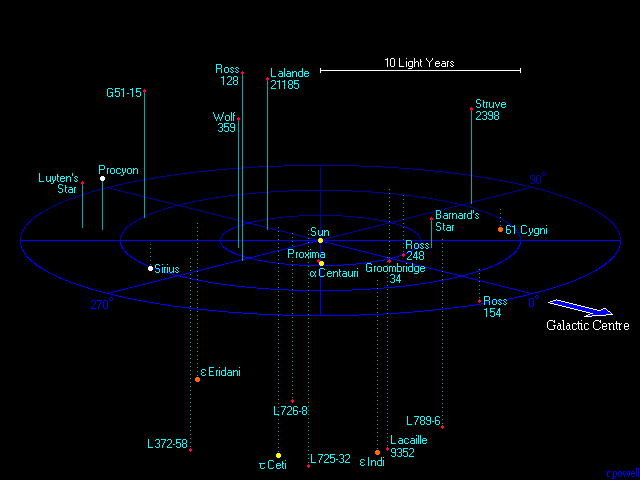| Topic: planets discovered outside the milky way for the 1st time | |
|---|---|
|
Norman - A University of Oklahoma astrophysics team has discovered for the
 first time a population of planets beyond the Milky Way galaxy. Using microlensing-an astronomical phenomenon and the only known method capable of discovering planets at truly great distances from the Earth among other detection techniques-OU researchers were able to detect objects in extragalactic galaxies that range from the mass of the Moon to the mass of Jupiter. http://www.ou.edu/content/publicaffairs/archives/2018/OUAstrophysictsDiscoverPlanetsinExtragalacticGalaxies.html Xinyu Dai, professor in the Homer L. Dodge Department of Physics and Astronomy, OU College of Arts and Sciences, with OU postdoctoral researcher Eduardo Guerras, made the discovery with data from the National Aeronautics and Space Administration's Chandra X-ray Observatory, a telescope in space that is controlled by the Smithsonian Astrophysical Observatory. "We are very excited about this discovery. This is the first time anyone has discovered planets outside our galaxy," said Dai. "These small planets are the best candidate for the signature we observed in this study using the microlensing technique. We analyzed the high frequency of the signature by modeling the data to determine the mass." While planets are often discovered within the Milky Way using microlensing, the gravitational effect of even small objects can create high magnification leading to a signature that can be modeled and explained in extragalactic galaxies. Until this study, there has been no evidence of planets in other galaxies. "This is an example of how powerful the techniques of analysis of extragalactic microlensing can be. This galaxy is located 3.8 billion light years away, and there is not the slightest chance of observing these planets directly, not even with the best telescope one can imagine in a science fiction scenario," said Guerras. "However, we are able to study them, unveil their presence and even have an idea of their masses. This is very cool science." For this study, OU researchers used the NASA Chandra X-ray Observatory at the Smithsonian Astrophysical Observatory. The microlensing models were calculated at the OU Supercomputing Center for Education and Research. A paper, "Probing Planets in Extragalactic Galaxies Using Quasar Microlensing," by Dai and Guerras on this study has been published in the Astrophysical Journal Letters. For more information about this research, contact OU Professor Dai at xdai@ou.edu. |
|
|
|
|
|
While it is an extremely interesting process of discovery, the distance makes me skeptical.
Too many things could give those detection, of which only one might be a planet. Normally planets are discovered by observation directly, star wobble and a dip in the light of the parent star. Microlensing, as far as I understand it, has to do with using gravitational influences to magnify a star that is not in line of sight. In other words, they use it to see around other stuff. With a star, which has its own light source the process is quite understandable but to measure a star like that to determine wobble or light diffusion seems too precise for such a detection method. Too many things can get in the way of the observation. Now, I'm also of the belief that the star, planet, moon model is universal, so, it is very likely that there are planets and moons in other galaxies. Since the scientific community accepts this data as accurate, it might actually be so but scientific observations in the past have proved wrong before. There might be a bit of fantasy involved with accepting this as empirical data. What I am waiting to see is an alternative method finding the same results. |
|
|
|
|
|
At 3.8 billion light years away, we'll never know if they're planets or not...
|
|
|
|
|
|
At 3.8 billion light years away, we'll never know if they're planets or not... Yeah, at 3.8 billion light years I don't think it really matters? Even at the speed of light it would take 3.8 billion years to get there. |
|
|
|
|
|
Could be an OUTER space Chinese resturaunt....Everybody loves Chinese!!!
Tom's point is correct in the fact that we are still infantile in the ways of Interplanetary cartography. We should just send probes in that direction and checkitout! |
|
|
|
|
|
Edited by
Tom4Uhere
on
Mon 02/05/18 01:50 PM
|
|
|
Even if the probes can achieve light speed it will still take 3.8 billion years for them to get there.
Consider that if they could achieve a billion times the speed of light it will take 3.8 years to get there. Try to imagine what a one way trip would be like if it took you 3.8 years non-stop to reach your destination. At our current technology, Mars is 2 years one way at its closest possible position to Earth. About the only thing that can make a 3.8 billion light year trip is the imagination. Other than fantasy fodder, it has no practical application. I'm more interested in planets and moons that are within our ability to reach. Right now that is basically our solar system. Perhaps in the future (100 yrs?) we may have the technology to reach the Alpha Centauri trinary system at 4.3 light years. 4.22 to Proxima Centauri our closest star after the Sun (Sol). In August 2016, the European Southern Observatory announced the discovery of a planet slightly larger than the Earth orbiting Proxima Centauri. The planet lies in the habitable zone of Proxima Centauri, but it is possible that the planet is tidally locked to the star, resulting in temperature extremes that would be difficult for life to overcome. ~ wiki In 2012, a planet around Alpha Centauri B was announced, but in 2015 a new analysis concluded that it almost certainly does not exist and was just a spurious artifact of the data analysis. ~ wiki Consider for a moment that the Centauri System is our closest stellar neighbor and even at that range mistakes are made. The sad fact is we have no idea exactly what is in that system and its the closest. 4.3 light years is much easier to resolve than 3.8 billion light years. |
|
|
|
|
|
In that case Tom....Lets not go to Camalot....It is a silly place....and 4 light years is waaaaayyyy too far!!
|
|
|
|
|
|
In that case Tom....Lets not go to Camalot....It is a silly place....and 4 light years is waaaaayyyy too far!! |
|
|
|
|
 This map shows all the star systems that lie within 12.5 light years of our Sun. Most of the stars are red dwarfs - stars with a tenth of the Sun's mass and less than one hundredth the luminosity. Roughly eighty percent of all the stars in the universe are red dwarfs, and the nearest star - Proxima - is a typical example. SOURCE - http://www.atlasoftheuniverse.com/12lys.html Sun - SOL Type=G2, Magnitude=-26.8, Distance=0.0000158 ly A typical yellow dwarf star. It has eight planets orbiting it. Proxima Centauri - Type=M5, Magnitude=11.0, Distance=4.22 ly This dim red dwarf is the nearest star to the Sun, and it is a member of the Alpha Centauri system despite lying 0.24 light years from the main pair of stars, requiring over one million years to orbit them. Proxima was discovered in 1915 by Robert Innes and was at that time the least luminous star known. It is also a flare star - capable of brightening a magnitude or more in minutes. Alpha Centauri A,B - Type=G2+K0, Magnitudes=0.0+1.4, Distance=4.39 ly Just slightly further from us than Proxima, lie the orange and yellow dwarf stars that make up Alpha Centauri. Orbiting each other in an 80 year period, together they make up one of the brightest objects in southern hemisphere skies. Seen from Alpha Centauri, the third member of the system, Proxima, is a dim (magnitude 4.8) star. Barnard's Star - Type=M5, Magnitude=9.6, Distance=5.94 ly Famous for having the largest proper motion of any star, this dim red dwarf travels 0.29 degrees against the background sky in a century. Discovered by E Barnard in 1916, it was thought in the 1960's to have a couple of unseen planets orbiting it, but later observations disproved this. In another 8000 years Barnard's Star will become the closest star to us. Wolf 359 - Type=M6, Magnitude=13.5, Distance=7.80 ly An excessively dim red dwarf discovered by Max Wolf in 1918. For 25 years it was the least luminous star known. Lalande 21185 - Type=M2, Magnitude=7.5, Distance=8.31 ly Recorded in JJ Lalande's star catalogue compiled in the 1790's, this is one of the brightest red dwarfs in the sky, but it still needs binoculars to see it. G Gatewood reported in 1996 the possible indications of a couple of Jupiter sized planets orbiting it but this remains unconfirmed. Sirius A,B - Type=A1+DA, Magnitudes=-1.4+8.4, Distance=8.60 ly This brilliant white star is the brightest star in the night sky and the most luminous star within 25 light years. Its white dwarf companion was first seen in 1852, the first white dwarf ever seen. The orbital period is 50 years. Luyten 726-8 A,B - Type=M5+M5, Magnitudes=12.4+13.3, Distance=8.73 ly This is a dim binary system consisting of two red dwarfs. The system is perhaps more famously known as UV Ceti, the variable-star name of the second star in the system. It is a famous flare star and can visibly brighten by several magnitudes as it ejects flares from its surface similar to the ones seen on the surface of the Sun, but far more energetic. Both stars require about 200 years to orbit each other. Ross 154 - Type=M4, Magnitude=10.4, Distance=9.69 ly A dim red dwarf. It is one of a number of nearby stars catalogued by Frank Ross in the 1930's. It is also a known flare star. Ross 248 - Type=M6, Magnitude=12.3, Distance=10.33 ly Another dim red dwarf. Epsilon Eridani - Type=K2, Magnitude=3.7, Distance=10.50 ly An orange dwarf star. This star was searched for signs of intelligent life with the Green Bank radio telescope in 1960. The results, predictably, were negative. The IRAS satellite detected a lot of dust orbiting this star indicating a possible forming solar system, and even more recently, (Aug 2000), a Jupiter sized planet has been detected orbiting this star at a distance of 3.2 AU (480 million km). Lacaille 9352 - Type=M2, Magnitude=7.4, Distance=10.73 ly A fairly bright red dwarf which can easily be seen with binoculars, it was first recorded in Nicolas de Lacaille's catalogue of southern hemisphere stars compiled around 1752. Ross 128 - Type=M4, Magnitude=11.1, Distance=10.89 ly A dim red dwarf, also known as FI Vir - its variable star designation. These stars are all within a 10 light year distance from Sol. 1 light-year = 9460730472580800 metres (exactly) ≈ 9.461 petametres ≈ 9.461 trillion kilometres ≈ 5.878625 trillion miles ≈ 63241.077 astronomical units ≈ 0.306601 parsecs One astronomical unit (the distance from the Sun to the Earth). It takes approximately 499 seconds (8.32 minutes) for light to travel this distance. The most distant space probe, Voyager 1, was about 18 light-hours away from the Earth as of October 2014. It will take about 17,500 years to reach one light-year (1.0×100 ly) at its current speed of about 17 km/s (38,000 mph) relative to the Sun. Proxima Centauri, the closest star to our own, is still 40,208,000,000,000 km away. (Or about 268,770 AU.) If Voyager were to travel to Proxima Centauri, at this rate, it would take over 73,000 years to arrive. Mankind has only been civilized for about 5,000 years |
|
|
|
|
|
I love Milky Ways
Creamy chocolate, caramel layer and fluffy chocolate fill.. Mmmm |
|
|
|
|










